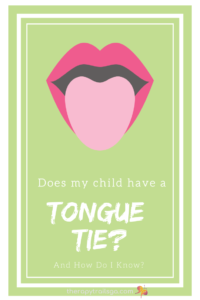Does my child have a tongue tie?
 It may seem like an odd talking point, but tongue-ties have become quite the buzzword these days. Not to mention, it has become an area that is sometimes even controversial! We wanted to take a moment and provide parents and caregivers with information and definitions that surround the topic of tongue-tie. We hope you learn something!
It may seem like an odd talking point, but tongue-ties have become quite the buzzword these days. Not to mention, it has become an area that is sometimes even controversial! We wanted to take a moment and provide parents and caregivers with information and definitions that surround the topic of tongue-tie. We hope you learn something!
What are they?
Tethered Oral Tissues (TOTs), or lip and tongue ties, are tight or restricted tissue (frenulum) connecting the tongue, lip, or cheek to the mouth causing reduced range of motion, or movement. The restriction of movement can impact feeding and swallowing, speech production and oral hygiene.
Signs and symptoms
Depending on the age of the child, as well as the type of TOTs, the restricted tissues can result in a variety of signs and symptoms.
Infancy
Difficulty latching to breast or bottle, painful nursing, difficulty sustaining suction during breast, bottle or pacifier, leaking milk out of the corners of the mouth, noisy clicking when drinking, coughing or choking during feeds, gassiness, reflux and even difficulty sleeping.
Childhood
Feeding and Swallowing: picky eating, avoiding certain food textures, reduced chewing, over-stuffing mouth while eating, holding foods in mouth, difficulty clearing food from teeth or cheeks after swallowing and coughing or choking on foods.
Speech Production: difficulty progressing with speech sounds. Lip ties can impact /b/, /p/, /m/, /o/, /sh/ and /r/ production. Tongue ties are more likely to impact /t/, /d/, /l/, /s/, /z/, /k/, /g/ and /r/ depending on severity and location (anterior or posterior) of restricted tissue.
Other signs and symptoms can include open-mouth resting posture (mouth breathing), dental issues, reflux and difficulty sleeping.
Identification
Speech Language Pathologists identify TOTs when completing Oral Mech Exam or when observing any of the above mentioned characteristics. Primary care physicians, dental professionals and ENTs also play a role in identification and classification of tethered oral tissues. TOTs are only diagnosed if the tight or restricted tissue is impacting function in some manner
Treatment
TOTs can require surgical intervention to release the tissue to allow for improved range of motion. The procedure is typically performed by a dentist or ENT specializing in tethered oral tissues and is a quick outpatient surgery.
Speech Language Pathologists provide oral motor exercises to improve range of motion, coordination and strength prior to and following completion of surgery. SLPs will also provide therapeutic intervention targeting safe eating and feeding skills, as well as regarding production of age appropriate sounds to improve speech intelligibility.
Helpful Resources
https://www.hopkinsmedicine.org/health/conditions-and-diseases/tongue-tie-ankyloglossia
https://tonguetieprofessionals.org/f-a-q/
https://www.mayoclinic.org/diseases-conditions/tongue-tie/symptoms-causes/syc-20378452
Have more questions? We’d be happy to help! Contact our office at info@therapytrailsga.com with your questions and we’ll get back with you soon.
